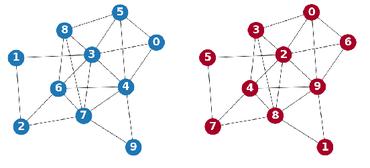Search Results for author: Elizabeth Munch
Found 17 papers, 2 papers with code
NervePool: A Simplicial Pooling Layer
no code implementations • 10 May 2023 • Sarah McGuire, Elizabeth Munch, Matthew Hirn
For deep learning problems on graph-structured data, pooling layers are important for down sampling, reducing computational cost, and to minimize overfitting.
Persistent Homology of Coarse Grained State Space Networks
no code implementations • 20 May 2022 • Audun D. Myers, Max M. Chumley, Firas A. Khasawneh, Elizabeth Munch
We contrast dynamic state detection from time series using a coarse-grained state-space network (CGSSN) and topological data analysis (TDA) to two state of the art approaches: ordinal partition networks (OPNs) combined with TDA and the standard application of persistent homology to the time-delay embedding of the signal.
Topological Signal Processing using the Weighted Ordinal Partition Network
no code implementations • 27 Apr 2022 • Audun Myers, Firas A. Khasawneh, Elizabeth Munch
For this task, we turn to the field of topological data analysis (TDA), which encodes information about the shape and structure of data.
Automatic Tree Ring Detection using Jacobi Sets
no code implementations • 17 Oct 2020 • Kayla Makela, Tim Ophelders, Michelle Quigley, Elizabeth Munch, Daniel Chitwood, Asia Dowtin
Tree ring widths are an important source of climatic and historical data, but measuring these widths typically requires extensive manual work.
Bifurcation Analysis using Zigzag Persistence
no code implementations • NeurIPS Workshop TDA_and_Beyond 2020 • Sarah Tymochko, Elizabeth Munch, Firas Khasawneh
As bifurcations in a dynamical system are drastic behavioral changes, being able to detect when these bifurcations occur can be essential to understanding the system overall.
Teaspoon: A comprehensive python package for topological signal processing
no code implementations • NeurIPS Workshop TDA_and_Beyond 2020 • Audun D Myers, Melih Yesilli, Sarah Tymochko, Firas Khasawneh, Elizabeth Munch
The emerging field of topological signal processing brings methods from Topological Data Analysis (TDA) to create new tools for signal processing by incorporating aspects of shape.
A family of metrics from the truncated smoothing of Reeb graphs
no code implementations • 15 Jul 2020 • Erin Wolf Chambers, Elizabeth Munch, Tim Ophelders
In this paper, we introduce an extension of smoothing on Reeb graphs, which we call truncated smoothing; this in turn allows us to define a new family of metrics which generalize the interleaving distance for Reeb graphs.
Computational Geometry
Fast and Scalable Complex Network Descriptor Using PageRank and Persistent Homology
no code implementations • 12 Feb 2020 • Mustafa Hajij, Elizabeth Munch, Paul Rosen
The PageRank of a graph is a scalar function defined on the node set of the graph which encodes nodes centrality information of the graph.
Chatter Diagnosis in Milling Using Supervised Learning and Topological Features Vector
no code implementations • 27 Oct 2019 • Melih C. Yesilli, Sarah Tymochko, Firas A. Khasawneh, Elizabeth Munch
In this study, we use topological features of data simulating cutting tool vibrations, combined with four supervised machine learning algorithms to diagnose chatter in the milling process.
Adaptive Partitioning for Template Functions on Persistence Diagrams
no code implementations • 18 Oct 2019 • Sarah Tymochko, Elizabeth Munch, Firas A. Khasawneh
As the field of Topological Data Analysis continues to show success in theory and in applications, there has been increasing interest in using tools from this field with methods for machine learning.
Persistent Homology of Complex Networks for Dynamic State Detection
no code implementations • 16 Apr 2019 • Audun Myers, Elizabeth Munch, Firas A. Khasawneh
Specifically, we show how persistent homology, a tool from TDA, can be used to yield a compressed, multi-scale representation of the graph that can distinguish between dynamic states such as periodic and chaotic behavior.
Chaotic Dynamics Computational Geometry Information Theory Information Theory Data Analysis, Statistics and Probability
Approximating Continuous Functions on Persistence Diagrams Using Template Functions
1 code implementation • 19 Feb 2019 • Jose A. Perea, Elizabeth Munch, Firas A. Khasawneh
Specifically, we begin by characterizing relative compactness with respect to the bottleneck distance, and then provide explicit theoretical methods for constructing compact-open dense subsets of continuous functions on persistence diagrams.
Using Persistent Homology to Quantify a Diurnal Cycle in Hurricane Felix
no code implementations • 17 Feb 2019 • Sarah Tymochko, Elizabeth Munch, Jason Dunion, Kristen Corbosiero, Ryan Torn
The diurnal cycle of tropical cyclones (TCs) is a daily cycle in clouds that appears in satellite images and may have implications for TC structure and intensity.
Isolating phyllotactic patterns embedded in the secondary growth of sweet cherry (Prunus avium L.) using magnetic resonance imaging
1 code implementation • 8 Dec 2018 • Mitchell Eithun, Daniel H. Chitwood, James Larson, Gregory Lang, Elizabeth Munch
Intensity values from Magnetic Resonance Imaging (MRI) of the trunk are projected onto the surface of a perfect cylinder to find the locations of traces in the "boundary image".
Chatter Classification in Turning Using Machine Learning and Topological Data Analysis
no code implementations • 23 Mar 2018 • Firas A. Khasawneh, Elizabeth Munch, Jose A. Perea
The features gleaned from the deterministic model are then utilized for characterization of chatter in a stochastic turning model where there are very limited analysis methods.
Topological and Statistical Behavior Classifiers for Tracking Applications
no code implementations • 1 Jun 2014 • Paul Bendich, Sang Chin, Jesse Clarke, Jonathan deSena, John Harer, Elizabeth Munch, Andrew Newman, David Porter, David Rouse, Nate Strawn, Adam Watkins
We introduce the first unified theory for target tracking using Multiple Hypothesis Tracking, Topological Data Analysis, and machine learning.




